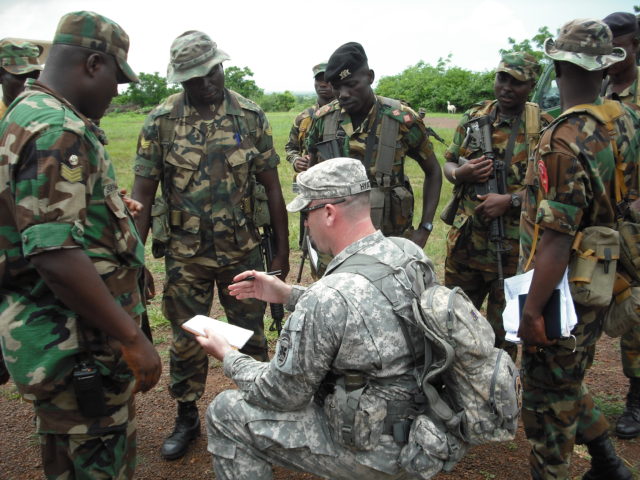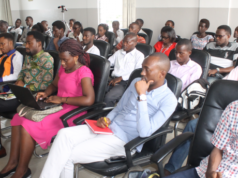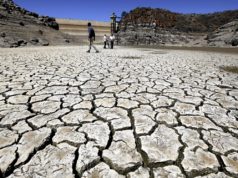
In early October 2017, a small group of U.S. troops joined local forces from the African nation of Niger on a patrol to gather information on extremists operating in that country. This was not unprecedented: as extremism spread across the northern half of Africa in recent years, American support to local security forces had become routine. This time, though, something went badly wrong. After meeting local leaders in the small town of Tongo Tongo, the patrol was ambushed by around 50 heavily armed militants. A 30 minute engagement left four U.S. troops dead and two more wounded. Suddenly Niger, which most Americans had never heard of before the attack, became front page news, sparking a broad discussion of U.S. security policy in Africa. The question now is whether this will – or should – lead to a shift in American strategy on that troubled continent.
Africa’s Extremist Threat
For the past few decades, Islamic extremists around the world have exploited local discontent and the psychological problems of alienated individuals to stoke revolutionary violence. Africa is particularly vulnerable. The continent has much to fuel extremism, whether communal tensions; a crushing lack of jobs and economic opportunity, exacerbated in many places by climate change; the decay of traditional authority structures; and governments unconcerned with security and development in places distant from the national capital. Africa is, as a 2016 study from the influential Center for Strategic and International Studies put it, “a fragile region under threat.”
Extensive research bears this out. For instance, the United Nations Development Programme has found that most African extremists come from marginalized regions within their country; have little exposure to other religions and ethnicities; and have few educational and economic opportunities. Most former extremists interviewed for the UN report mentioned employment as their most immediate need. Like inner city gangs in the United States, joining an extremist insurgency often is a way to make living while gaining a degree of status and power normally unavailable to poor youth.
While marginalization and the lack of opportunity exist in many parts of Africa, they are especially dangerous when weaponized by a violent, revolutionary ideology derived from Islam. As in many parts of the world, Muslims with a limited understanding of their religion and a psychological need for an externally-defined purpose in life are particularly susceptible to an ideology that gives the appearance of being based on faith. Much like the Christianity that was turned into an ideology that inspired Crusaders from northern Europe or Spanish conquistadores in earlier times, Islam is a proselytizing religion which can be distorted for political purposes.
Violent Islamic extremism in its contemporary form first appeared in North Africa during the brutal Algerian civil war from 1991-2002. It gained a foothold in East Africa as Osama bin Laden’s al-Qaeda moved its operations from Afghanistan to Sudan and the Egyptian Islamic Jihad movement engineered the bloody 1998 bombings of the U.S. embassies in Tanzania and Kenya. By 2006, East Africa’s extremism problem grew much worse as a militant organization known as al-Shabaab emerged in Somalia and later began terrorist attacks in neighboring Uganda and Kenya.
In recent years, violent Islamic extremism spread to West Africa and the transitional zone between the Sahara Desert and the savanna regions known as the Sahel. Today al-Qaeda in the Islamic Maghreb (AQIM), which is focused on overthrowing the government of Algeria, has connections or cells throughout North Africa, the Sahel, and West Africa. Boko Haram, which originated in Nigeria, now operates in neighboring nations like Cameroon, Chad, and Niger. And there are several Islamic State (ISIS) affiliates including the Islamic State of the Greater Sahara which is thought to have been behind the recent attack in Niger, and the Islamic State West Africa Province, which split from Boko Haram.
Of these movements, ISIS has the most growth potential in part because it has established a well-known global brand with transnational appeal, and in part because it is effective at online recruiting, giving it access to the rapidly expanding pool of young Africans with cell phone-based Internet access.
It is hard, though, to pin down the fluid, shifting web of violent extremism in Africa. There are many splinter groups and individual fighters sometimes move from one to another. For all of them, arms are readily available, many flowing out of Libya after the collapse of Moammar Qaddafi’s regime. Like insurgency-based extremist movements around the world, the ones in Africa are also deep into crime, using it to fund operations and attract recruits. The weakness of local governments, police and security forces, and the remoteness of much of the region gives the militants operating space.
Luckily none of Africa’s extremistsmovements are close to taking over a nation or creating a viable “caliphate.” But they can weaken fragile governments, stifle economic growth, attack U.S. and other Western targets, and create humanitarian crises in what is already a desperately poor and environmentally precarious part of the world. This has cascading effects: less economic growth and opportunity in West Africa and the Sahel means more young people attempting to cross the Mediterranean for Europe, potentially bringing extremism with them.
Today the militants cannot win but African governments cannot eradicate them. The result is a stalemate which mostly victimizes Africans who are not rich or powerful enough to surround themselves with armed security.
America’s Light Footprint
Since the end of the Cold War, the United States has considered sub-Saharan Africa a region with great economic and political promise but one that needs some assistance with security to reach it. Because U.S. national interests in Africa are modest and Africa itself, with a painful legacy of colonialism, is wary, even hostile toward outsiders influencing regional security, American involvement has been small scale and low key, focused mostly on increasing the capability of local security forces. In American military parlance, Africa is an “economy of force” theater of operations.
During the 1990s, Washington developed modest training and assistance programs to augment the professionalism of African security forces and help them become more effective at peacekeeping. After the Sept. 11, 2001 attacks America’s focus immediately shifted from peacekeeping to counter-terrorism. To direct this fight against extremism the United States created the U.S. Africa Command (AFRICOM) and refined its geographical focus in Africa, concentrating on the northern half of the continent. The single biggest U.S. military presence is in the Horn of Africa but the Pentagon has support and advisory programs across the continent in the places where violent extremism has a foothold. AFRICOM describes its strategy as “a light, adaptable footprint enabling joint operations, protection of U.S. personnel and facilities, crisis response, and security cooperation” which “seeks to disrupt and neutralize transnational threats by building African partner defense capability and capacity.” According to the 2017 AFRICOM posture statement, this is designed to “advance American interests with a combination of strategic patience, targeted investments, and strong partnership to achieve shared security objectives and maintain our long-term approach, which contribute to the conditions for development and good governance to take root. If we focus on working with our African partners on developing local solutions to radicalization, destabilization, and persistent conflict, we will remain the security partner of choice for the next decade, all while upholding our American values. Africa, our allies, the U.S., and, indeed, the world will benefit from our actions to promote stable and effective nation states and defense institutions in Africa.”
While the United States occasionally strikes extremists directly using manned and unmanned aircraft or special operations forces, the core of the light footprint strategy is working indirectly through local partners to minimize the American presence on the ground. Over the past few years Niger has become particularly important. It is one of the poorest nations on earth but is also in one of the world’s most dangerous neighborhoods, bordering Algeria, Libya, Mali, and Nigeria, all struggling with Islamic extremism.
While AFRICOM stresses that the United States “does not have an active, direct combat mission in Niger,” it has stated that there are around 800 American military personnel there, most involved operating drone bases. Quietly and out of the limelight, Niger became a pivotal partner in the fight with Islamic extremism.
A Complicated Path Ahead
In the broadest sense, America’s light footprint strategy in Africa is a compromise driven by competing, even contradictory demands. On one hand, Washington feels that it must do something to blunt extremism and help African nations victimized by it. On the other hand, neither Americans nor Africans want extensive U.S. military involvement. Thus the light footprint strategy is an effort to do something while limiting costs and minimizing the chances of being drawn in more deeply.
Like all compromises, this is far from perfect. U.S. troops helping African security forces have limited support, particularly in terms of airpower and medical evacuation. The October fight in Niger showed the danger of that. In places with a more extensive U.S. presence like the Iraq/Syria theater or Afghanistan, reinforcements, close air support and medical evacuation are normally minutes away. In Niger, it was hours. That amplifies the danger that U.S. forces face during counter extremism missions in Africa and increases the chances of something going wrong.
Since the low footprint strategy focuses on augmenting the capabilities of African governments and security forces, the United States can be no more successful than these partners. If America’s allies prove inept, brutal, corrupt, or simply uninterested in taking the measures needed to eliminate the political and economic problems that breed extremism, then the United States fails. This is an enduring dilemma since local governments often resist deep political and economic reform because national elites have a vested personal interest in the existing system. This means that America’s partners often welcome security assistance but not political advice.
For all of these reasons, the low footprint strategy is not a path to victory over extremism but a way to contain and manage it. While this is realistic in today’s political context, Americans don’t normally think of security in terms of threat management but rather as winning and losing. Success—victory—is defined as eliminating enemies. The question is whether American policymakers and opinion shapers will adjust to and accept the idea of threat management in Africa and calm the public when bad things happen – like the October fight in Niger or if one of America’s African partners turns brutal, even genocidal. This matters greatly because in a conflict like the one with Islamic extremists, bad things invariably happen.
Today America’s indirect, low footprint counter-extremism strategy in Africa is the best option available. Whether it can be sustained long enough to work-or whether strategic success is even possible—remains to be seen. Until a few months ago most Americans had never heard of Niger but they may hear more of it in the future. Along the way other African nations, little known in the United States, may make headlines in the global conflict with violent Islamic extremism.
Steven Metz, Ph.D., is Director of Research and Research Professor of National Security Affairs at the U.S. Army War College Strategic Studies Institute (SSI). This article does not represent the official position of the U.S. Army or U.S. Army War College.





